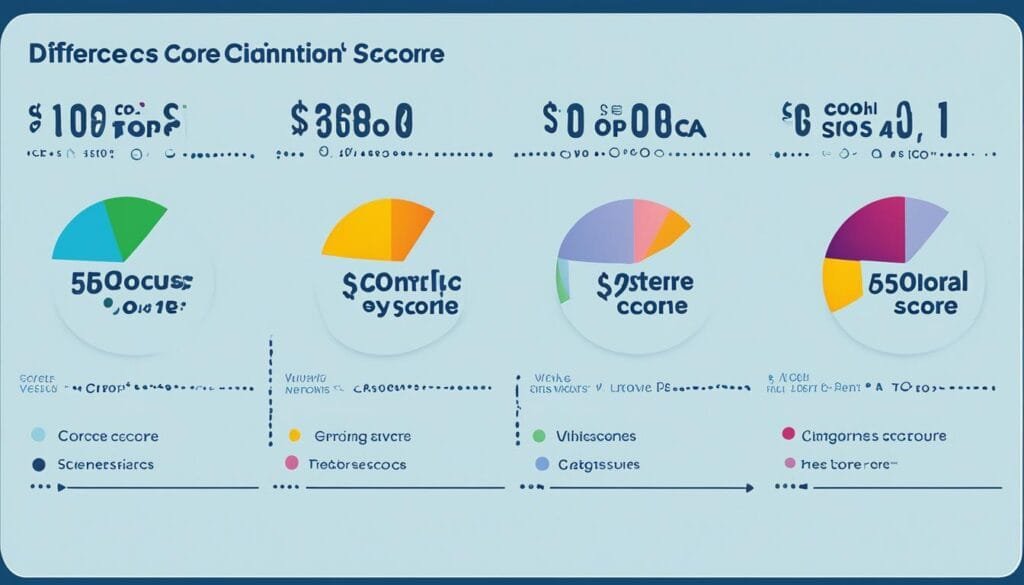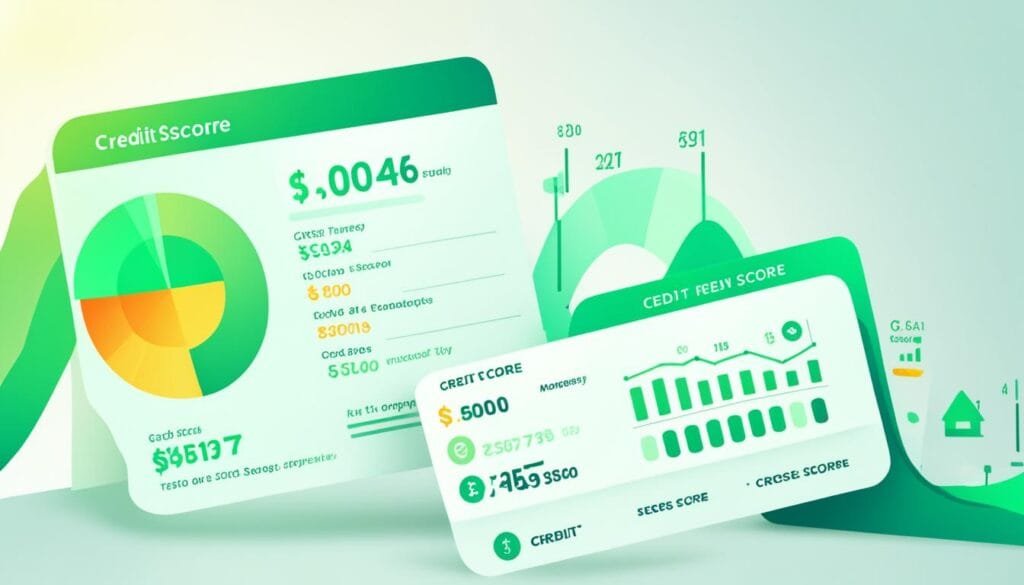A credit score is a three-digit number that represents how likely you are to repay borrowed money and pay bills. It is calculated based on information from your credit accounts and compiled into credit reports by bureaus like Equifax, Experian, and TransUnion. The two main credit scoring models used in the U.S. are FICO and VantageScore, with scores ranging from 300 to 850. While a perfect score of 850 is not necessary, having a higher credit score can give you access to more credit products and lower interest rates. It’s important to understand credit score ranges and benchmarks to manage your credit effectively and improve your score if needed.
- Credit scoring models, such as FICO and VantageScore, calculate credit scores based on your credit accounts and payment history.
- Credit scores range from 300 to 850, with higher scores indicating better creditworthiness.
- Understanding credit score ranges and benchmarks is important for managing your credit effectively.
- Factors such as payment history, credit utilization, and credit mix influence your credit score.
- Improving your credit score involves making on-time payments, keeping credit card balances low, and maintaining a mix of credit types.
Understanding Credit Score Ranges
When it comes to credit scores, creditors set their own standards for what scores they will accept. However, there are general guidelines for credit score ranges that can give you an idea of where you stand. The two commonly used credit scoring models in the U.S. are FICO and VantageScore.
In the FICO scoring model, credit scores are categorized as follows:
Below 580: poor credit
580 to 669: fair credit
670 to 739: good credit
740 to 799: very good credit
800 and above: exceptional credit
On the other hand, the VantageScore model organizes credit scores into the following ranges:
300 to 600: subprime credit
601 to 660: near prime credit
661 to 780: prime credit
781 to 850: superprime credit
It’s important to note that the average credit score in the U.S. can vary slightly between the two scoring models. Based on recent data, FICO 8 has an average score of 718, while VantageScore 3.0 has an average score of 700.
Factors Affecting Credit Score Benchmarks
Your credit score is influenced by several factors that play a crucial role in determining your creditworthiness. Understanding these factors can help you make informed decisions to improve your credit score.
Payment History
Payment history is one of the most significant factors affecting your credit score. It accounts for a substantial portion of your score, highlighting the importance of making on-time payments. Consistently paying your bills by their due dates demonstrates your responsibility and reliability in managing credit.
Credit Utilization
Credit utilization refers to the percentage of your available credit that you are currently using. Keeping your credit utilization below 30% is crucial for maintaining a good credit score. High credit utilization can indicate financial strain or potential reliance on credit, which may negatively impact your creditworthiness.
Length of Credit History
The length of your credit history also affects your credit score. Lenders prefer borrowers with a longer credit history as it provides more insight into their financial habits. Responsibly managing credit over an extended period demonstrates stability and reliability, which can positively impact your credit score.
Credit Mix
Having a diverse credit mix can contribute to a higher credit score. A healthy credit mix includes different types of credit accounts, such as credit cards, installment loans, and mortgages. Demonstrating the ability to manage various types of credit responsibly indicates versatility and can positively affect your credit score.
Recent Credit Applications
Recent credit applications, also known as hard inquiries, can have a temporary impact on your credit score. Applying for multiple credit accounts within a short period can be perceived as a financial risk. It’s best to limit the number of credit applications to maintain a stable credit score.
“Understanding the factors that affect your credit score is crucial for managing your credit responsibly. By prioritizing responsible payment behavior, maintaining a low credit utilization ratio, and diversifying your credit mix, you can work towards achieving a higher credit score.”
It’s important to note that certain demographic characteristics, such as race, ethnicity, and age, are not considered in credit score calculations. Credit scoring models focus solely on credit-related factors to ensure fair and unbiased evaluations.
| Factors Affecting Credit Score Benchmarks | Impact on Credit Score |
|---|---|
| Payment History | Major impact |
| Credit Utilization | Significant impact |
| Length of Credit History | Moderate impact |
| Credit Mix | Moderate impact |
| Recent Credit Applications | Minor impact |
Improving Your Credit Score Benchmarks
If you want to improve your credit score, there are several steps you can take. By following these strategies, you can enhance your creditworthiness and achieve a good credit score benchmark.
- Paying bills on time: Timely bill payments play a crucial role in improving your credit score. Set up automatic payments or use reminders to ensure you never miss a due date.
- Keeping credit card balances low: Aim to keep your credit card balances below 30% of their limits. This demonstrates responsible credit utilization and can positively impact your credit score.
- Maintaining older credit cards: Keeping your older credit cards open can help maintain the average age of your accounts. This can be beneficial for your credit score, as a longer credit history indicates stability.
- Diversifying your credit types: Having a mix of credit types, such as credit cards, loans, and mortgages, can positively influence your credit score. It demonstrates your ability to manage various forms of credit responsibly.
- Avoiding excessive credit applications: Applying for multiple lines of credit within a short period can result in hard inquiries on your credit report. These inquiries can temporarily lower your credit score, so it’s best to limit applications to when they are necessary.
- Building credit: If you’re starting out and have limited credit history, consider opening a secured credit card or becoming an authorized user on someone else’s credit card. These actions can help you begin building a positive credit history.
- Disputing errors: Regularly check your credit reports for any errors or inaccuracies. If you find any, dispute them with the credit bureaus to ensure your credit score accurately reflects your creditworthiness.
The Importance of Responsible Credit Behavior
Improving your credit score benchmarks requires responsible credit behavior and consistent effort. By adopting good financial habits and making informed credit decisions, you can steadily enhance your creditworthiness over time.
Remember, improving your credit score is a gradual process, so it’s important to be patient and persistent. Stick to your financial goals and monitor your progress regularly. With discipline and dedication, you can achieve a good credit score benchmark and enjoy the benefits of better financial opportunities.

Comparison: FICO Score vs. VantageScore
| FICO Score | VantageScore |
|---|---|
| Ranges from 300 to 850 | Ranges from 300 to 850 |
| Calculates scores based on payment history, credit utilization, credit history length, credit mix, and recent credit applications | Considers similar factors in scoring models |
| Used by many lenders as a primary credit scoring model | Increasingly used by lenders alongside FICO scores |
| May result in slight score variations due to differences in scoring formulas | May result in slight score variations due to differences in scoring formulas |
Differences Between FICO Score and VantageScore
When it comes to credit scoring models, two prominent names stand out in the United States: FICO and VantageScore. Both FICO and VantageScore assign credit scores within the range of 300 to 850, taking into account factors such as payment history and credit utilization. However, it’s important to note that your FICO and VantageScore credit scores may vary slightly due to differences in their scoring formulas and the data they consider.
FICO, created by the Fair Isaac Corporation, has been the industry standard for over 30 years. It uses specific algorithms to weigh different aspects of your credit history. On the other hand, VantageScore, developed collaboratively by the three major credit bureaus (Equifax, Experian, and TransUnion), utilizes a different scoring model designed to provide a more consistent evaluation across all three bureaus.
FICO and VantageScore may generate varying credit scores because each model has its unique way of interpreting credit data and calculating scores. For instance, FICO scores may place greater emphasis on certain factors, such as recent credit inquiries, while VantageScore might consider a broader range of credit behavior, taking into account alternative data sources.
“Understanding the differences between FICO Score and VantageScore is essential for managing your credit effectively. While both scores provide an assessment of your creditworthiness, it’s important to note that different lenders may use different scoring models when evaluating your creditworthiness.”
It’s crucial to have a clear understanding of the credit scoring models being used to assess your creditworthiness. While it’s normal for your FICO and VantageScore credit scores to vary slightly, the overall factors that impact your scores, such as payment history and credit utilization, remain consistent. Monitoring both scores and focusing on maintaining healthy credit habits is key to improving and maintaining good credit.
Comparing FICO Score and VantageScore
| FICO Score | VantageScore |
|---|---|
| Developed by the Fair Isaac Corporation | Developed collaboratively by Equifax, Experian, and TransUnion |
| Industry standard for over 30 years | Introduced in 2006 as a competitor to FICO |
| Uses specific algorithms to weigh credit factors | Considers a broader range of credit behavior |
| May place higher importance on recent credit inquiries | Takes into account alternative data sources |

By understanding the differences between FICO Score and VantageScore, you can effectively manage your credit and make informed decisions when seeking credit opportunities. Remember, your credit scores serve as key indicators of your creditworthiness, and maintaining a good credit profile can provide access to better interest rates, loan approvals, and other financial opportunities.
Can Credit Score Simulation Tools Help Me Understand U.S. Credit Score Benchmarks?
Credit score simulation tools can provide valuable insight into U.S. credit score benchmarks. By using these tools, you can better understand how certain financial decisions may impact your credit score. Additionally, they can help you gauge where your credit score stands in relation to average benchmarks.
Conclusion
Understanding credit score benchmarks is crucial for effectively managing your credit. By familiarizing yourself with the credit score ranges and factors that influence your score, you can make informed decisions and take the necessary steps to improve your creditworthiness.
Developing good credit habits, such as making timely payments and keeping your credit card balances low, can gradually raise your credit score benchmark over time. Remember, credit scores are not fixed and can be improved through responsible credit behavior.
By staying proactive and disciplined in your financial activities, you can achieve a higher credit score and gain access to better credit products and interest rates. So, take charge of your credit health and make the necessary changes today to secure a brighter financial future tomorrow.
FAQ
What is a credit score?
A credit score is a three-digit number that represents how likely you are to repay borrowed money and pay bills.
How is a credit score calculated?
A credit score is calculated based on information from your credit accounts and compiled into credit reports by bureaus like Equifax, Experian, and TransUnion.
What are the credit scoring models used in the U.S.?
The two main credit scoring models used in the U.S. are FICO and VantageScore.
What is the credit score range?
Credit scores range from 300 to 850.
What are the credit score categories in the FICO scoring model?
The credit score categories in the FICO scoring model are below 580 (poor credit), 580 to 669 (fair credit), 670 to 739 (good credit), 740 to 799 (very good credit), and 800 and above (exceptional credit).
What are the credit score categories in the VantageScore model?
The credit score categories in the VantageScore model are 300 to 600 (subprime credit), 601 to 660 (near prime credit), 661 to 780 (prime credit), and 781 to 850 (superprime credit).
What is the average credit score in the U.S.?
The average credit score in the U.S. varies slightly between the two scoring models, with FICO 8 averaging 718 and VantageScore 3.0 averaging 700.
What factors affect my credit score?
Factors that affect your credit score include payment history, credit utilization, length of credit history, credit mix, and recent credit applications.
How can I improve my credit score?
You can improve your credit score by making on-time payments, keeping credit card balances low, maintaining older credit cards, having a mix of credit types, avoiding excessive credit applications, building credit when starting out, and disputing errors on your credit reports.
Why are my FICO and VantageScore credit scores different?
The FICO and VantageScore credit scores may be slightly different because they use variations in their scoring formulas and may be based on different data from the credit bureaus.
How important are credit score benchmarks?
Understanding credit score benchmarks is essential for managing your credit effectively and making informed financial decisions.
Can I improve my credit score over time?
Yes, you can improve your credit score over time by practicing responsible credit behavior, such as making on-time payments and keeping credit card balances low.

